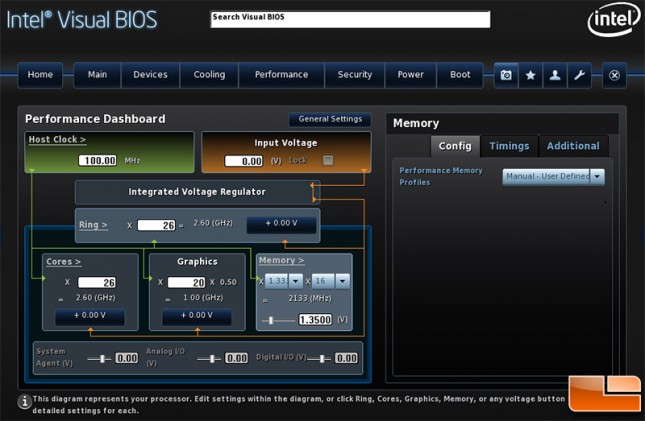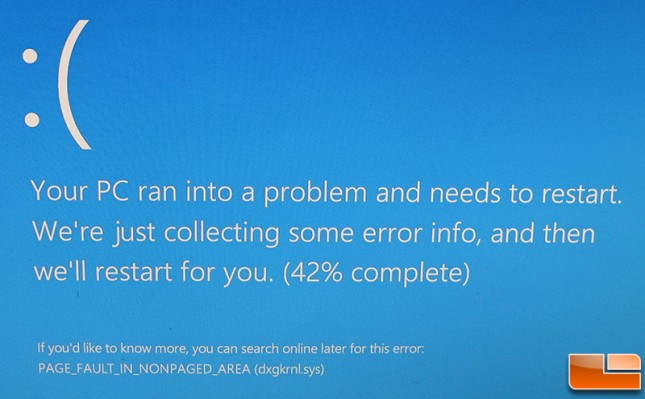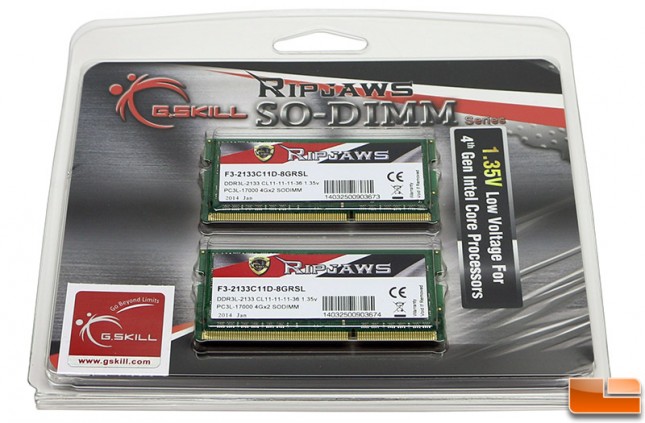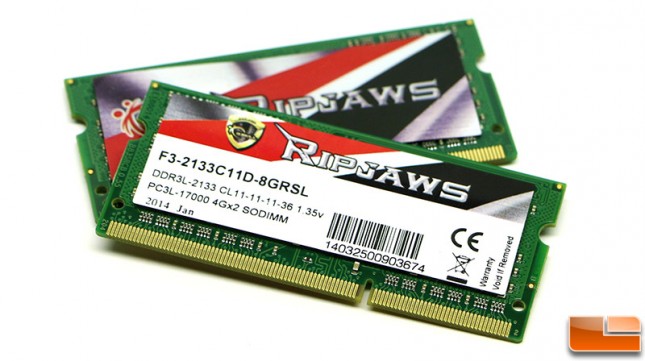G.SKILL Ripjaws 8GB 2133MHz DDR3L SO-DIMM Memory Kit Review – F3-2133C11D-8GRSL
Overclocking and Final Thoughts
Overclocking:
Overclocking the G.SKILL F3-2133C11D-8GRSL notebook memory kit was pretty nerve racking. For starters the highest memory divider in the Intel NUC Kit D54250WYK boards BIOS allows for even number adjustments between 8-16, so 2133MHz (1.333 x 16) is the maximum speed you can run DDR3L memory at inside the Intel NUC.

Since you can’t raise the memory multiplier beyond 16, the only thing we could do was to try and tighten the timings. This memory kit comes with 11-11-11-36 1T timings and if we lowered that to 10-11-10-36 or 11-11-11-32 we would crash on the desktop when the system first booted or we couldn’t even get a successful boot. We even tried bumping up the voltage from 1.35V to 1.425V with the tighter timings to see if more power to the modules might help, but it did not.

It appears that either this G.SKILL RIPJAWS SO-DIMM memory kit is pretty much maxed out or the Intel NUC Kit D54250WYK PC is unable to support anything tighter. We have a feeling that it might be a mixture of both as we’ve had troubles running 2133MHz memory in the past on the platform and running 16GB (2x8GB) memory kits at 1866MHz and above usually doesn’t work either. The Intel NUC D54250WYK and D54250WYKH are both solid platforms, but when you toss in some overclocked memory or high-capacity memory, you start to see some weak points. Our testing has found those wanting to run 16GB of memory in the NUC are best to stick with a 1600MHz memory kit and those that are wanting to go with 8GB of memory can get away with 2133MHz or 1866MHz, with the latter being the sweet spot.
Final Thoughts and Conclusions:

We’ve been wanting to run a 2133MHz DDR3L memory kit on 4th Generation Intel ‘Haswell’ processors for some time now and the G.SKILL F3-2133C11D-8GRSL has finally made that happen. Over the years we have learned that the performance difference between 1866MHz and 2133MHz memory is rather small and that proved to be true again here. The memory sweet spot on the Intel NUC Kit D54250WYK is most certainly 1866MHz, but we did see some integrated graphics performance improvements at 2133MHz. If you plan on gaming and want to get the most performance out of your notebook or PC that uses DDR3L SO-DIMMs, something like the G.SKILL RIPJAWS 2133MHz kit would be worthwhile. If you don’t care about squeezing the most performance out of the Intel HD graphics solution an 1866MHz memory kit will save you a few bucks and give you nice performance gains over running 1333MHz or 1600MHz memory kits. Changing out memory is one of the simplest ways to get a little more out of your system and there is certainly some benefits to be had from using faster memory.

When it comes to pricing the G.SKILL RIPJAWS Series 8GB 1866MHz CL11 memory kit F3-1866C11D-8GRSL runs $82.99 shipped and the 8GB 2133MHz CL11 memory kit F3-2133C11D-8GRSL runs $89.99 shipped. Both kits are lifetime warrantied and cost lower than any other brands comparable kits at this capacity and clock frequency. G.SKILL pretty much has the performance notebook memory market locked down as they have the best prices. They also were the first company to bring these high-end kits to market.
Which kit of memory would we go with? If you want to push the bleeding edge and are okay with manually setting your memory timings in your platforms BIOS, we suggest going with the G.SKILL RIPJAWS F3-2133C11D-8GRSL memory kit for $7 more. Why? We were able to easily downclock it to 1866MHz with 11-11-11-32 1T timings, so it will do everything the lower cost kit will do and remember the 1866MHz kit couldn’t be overclocked to 2133MHz. We like using flexible memory that pushes PCs today as it might still be relevant when you go to update or build another PC down the road.
We can easily recommend the G.SKILL RIPJAWS F3-2133C11D-8GRSL memory kit to those building a high-performance system that needs DDR3L 1.35V SO-DIMM memory.

Legit Bottom Line: The G.SKILL RIPJAWS Series 8GB 2133MHz CL11 memory kit was found to push the boundaries of what most platforms that use SO-DIMMs can do!
